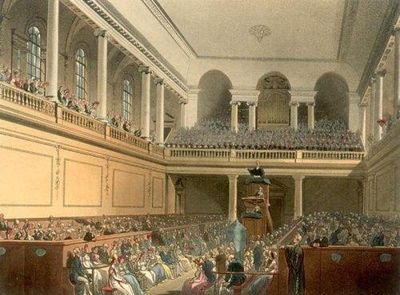Messiah: Difference between revisions
| Line 42: | Line 42: | ||
== Score and Parts == | |||
* [http://scores.ccarh.org/handel/messiah/messiah-fullscore.pdf Full Score], 280 pages. | * [http://scores.ccarh.org/handel/messiah/messiah-fullscore.pdf Full Score], 280 pages. | ||
Revision as of 23:37, 8 December 2011
Messiah (HWV 56) Composed by George Frideric Handel
Handel's most famous and most often performed work is the oratorio Messiah, composed in 1741 and first performed in Dublin in 1742. Many individual numbers within the work have become independently familiar.
As it comes to us in the twenty-first century, Messiah is unusual in several respects. Its text suggest that it is a sacred work, but it has enjoyed a substantial life as concert fare. A north German in the service of the British crown, Handel's oratorios were symbols of the (protestant) Church of England and its stature in British society. Dublin, which we know today as the capital of Eire (Ireland), was heavily dominated in Handel's time by English gentlemen.
The First Messiah
Because the response the Handel's first series of subscription concerts in Dublin had been so substantial, a second series was launched on February 17, 1742 with the performance of Alexander's Feast. The series continued on Wednesdays through April 7, when the featured work was a revised version of Esther. Dublin was by now well primed for the open rehearsal of Messiah that took place the following day.
The work's fame was instant, for on the basis of this one rehearsal Messiah was deemed "the finest Composition of Musick that ever was heard." The official premiere, on April 13 (a Tuesday) at noon, sustained its lofty reputation. (Because of the anticipated crowds, women were advised not to wear hoops to the performance.) Charles Jennens' libretto for the work was sold in Dublin for sixpence. When Messiah had its final Dublin performance, on June 3, there were some changes of cast and organ concertos were performed with it. Other concerts filled the intervening weeks. Among them were a benefit for the Dublin music publishers William and Bartholomew Mainwaring, and Handel's oratorio Saul. Its Dead March became an instant favorite that is still often performed.
Messiah had come into being at the request of Dublin's Charitable Infirmary to compose a work to encourage contributions to the "Dublin sick." At the time hospitals were used more to separate the sick from the rest of society than to treat their maladies.
It was structured in three parts: (1) music narrating highpoints from the prophecy of Isaiah to the early life of Jesus; (2) his death and resurrection; and (3) the sins and judgment of mankind. Each of these can be parsed into several scenes.
The best-known and most widely performed numbers come from particular passages: the first, fourth, and fifth scenes of Part One (the tenor aria "Every valley shall be exalted" from the first; the Pifa (pastoral symphony) introducing the angel and shepherds in the fourth; and the duet "He shall feed his flock" in the fifth, with its sequel and final chorus, "His yoke is easy."
Highlights of Part Two (seven scenes) include the alto aria "He was despised" (Sc. 1), the soprano aria "How beautiful are the feet" (Sc. 5), the bass aria "Why do the heathens so furiously rage together" (Sc. 6), the the "Hallelujah Chorus" (Sc. 7), which concludes the section.
Part Three (four scenes) opens with the soprano aria "I know that my Redeemer liveth." The bass aria "The trumpet shall sound," which prophecies Judgment Day, occurs in Sc. 2. Inevitably the work concludes with a chorus, "Worthy is the lamb."
The Messiah Phenomenon
Because of the immediate popularity of individual choral and vocal numbers in Messiah, the work was rapidly circulated and adapted to varying circumstances. The rise of choral societies in the third quarter of the century had a symbiotic relationship with Handel's masterpiece. The more the work was performed, the greater the number of groups performing it. Inevitably, each new venue created its own opportunities and limitations. Soloists and sometimes keys of particular pieces could be altered. Orchestration accommodated the resources available. On the whole, the size both increased.
These trends continued in the nineteenth century such that by the time of the Crystal Palace Exposition (in London in xx) the proportions reached what seems to have been their maximum extent: xx.
Two of the most durable milestones of eighteenth-century dissemination were the Foundling Hospital parts (xx) and the Samuel Arnold edition (178xx).
The Foundling Hospital Parts

London's Foundling Hospital, established on Bloomsbury Fields in 1739, mirrored in its aims the well established institutions for orphans in Italy and France. The famous of these was the Ospedale della Pietà in Venice, where all the orphans were female and where a select group reached the stature of musical professionals under the tuition of such maestri as Antonio Vivaldi.
Such institutions fostered strong musical allegiances because the noble families who supported them believed that music bettered the soul. They cherished music made well by children. The Foundling Hospital's benefactors include such noted painters as Sir Joshua Reynolds, Thomas Gainsborough, and Handel himself. The composer provided an organ and gave benefit performances at the Hospital. At his death, a valuable set of performance parts fell became the possession of the institution. Today the park known as "Coram's Fields" marks the spot where the original Hospital stood.
The Arnold Edition
Score and Parts
- Full Score, 280 pages.